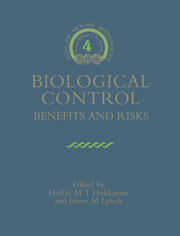Book contents
- Frontmatter
- Contents
- List of Contributors
- Series Preface
- Preface: Overview of Benefits and Risks of Biological Control Introductions
- Part I Biological Invasions
- Part II Classical Biocontrol
- Part III Augmentative Biocontrol
- Part IV Use of Genetically Modified Organisms
- 19 Assessing the Potential Benefits and Risks of Introducing Natural and Genetically Manipulated Bacteria for the Control of Soil-borne Root Diseases
- 20 Serodiagnostic Methods for Risk Assessment of Pseudomonas cepacia as a Biocontrol Agent
- 21 Benefits and Risks of Using Genetically Engineered Baculoviruses as Insecticides
- 22 Mathematical Modelling of Gene Exchange in Soil
- 23 Pest Resistance to Bacillus thuringiensis: Ecological Crop Assessment for Bt Gene Incorporation and Strategies of Management
- 24 An International Perspective for the Release of Genetically Engineered Organisms for Biological Control
- Part V Economics and Registration
- Index
19 - Assessing the Potential Benefits and Risks of Introducing Natural and Genetically Manipulated Bacteria for the Control of Soil-borne Root Diseases
Published online by Cambridge University Press: 07 May 2010
- Frontmatter
- Contents
- List of Contributors
- Series Preface
- Preface: Overview of Benefits and Risks of Biological Control Introductions
- Part I Biological Invasions
- Part II Classical Biocontrol
- Part III Augmentative Biocontrol
- Part IV Use of Genetically Modified Organisms
- 19 Assessing the Potential Benefits and Risks of Introducing Natural and Genetically Manipulated Bacteria for the Control of Soil-borne Root Diseases
- 20 Serodiagnostic Methods for Risk Assessment of Pseudomonas cepacia as a Biocontrol Agent
- 21 Benefits and Risks of Using Genetically Engineered Baculoviruses as Insecticides
- 22 Mathematical Modelling of Gene Exchange in Soil
- 23 Pest Resistance to Bacillus thuringiensis: Ecological Crop Assessment for Bt Gene Incorporation and Strategies of Management
- 24 An International Perspective for the Release of Genetically Engineered Organisms for Biological Control
- Part V Economics and Registration
- Index
Summary
Introduction
The application of biological control agents is an established if under-exploited method for the control of agricultural pests and diseases. There are considerable benefits to be gained from this approach, however caution is necessary in the introduction of biocontrol agents because of possible effects on non-target organisms. In some situations the biocontrol organism itself may become a pest.
There are numerous examples of experimental biocontrol treatments for fungal and bacterial plant root diseases, though on a practical level there are less examples than for control of insect pests. Plant root diseases can often be controlled by management practices such as rotation with a non-host crop or by several years of crop monoculture, a practice which can lead to the build-up of a disease-suppressive soil (Hornby, 1983). Microbially mediated disease suppression can also occur in soil-less potting mixes (Hoitink and Fahy, 1986). Fungicides (e.g. Baytan for control of take-all) are used for control of disease, but success has been limited especially when applied to field crops. Biological control agents used to control soil-borne root diseases are most commonly soil bacteria or fungi.
On the whole, there are relatively few publications dealing with risk assessment in the literature on biocontrol. Recent papers include that by de Jong et al (1990). The need for risk assessment is now much greater, particularly as genetic manipulation is beginning to be used more often in biological control (Jones and Kerr, 1989; Ryder and Jones, 1991). The use of recombinant DNA technology brings its own risks and benefits. Given that there are both risks and benefits for pest control methods, procedures for their estimation are desirable.
- Type
- Chapter
- Information
- Biological ControlBenefits and Risks, pp. 209 - 216Publisher: Cambridge University PressPrint publication year: 1995
- 3
- Cited by



